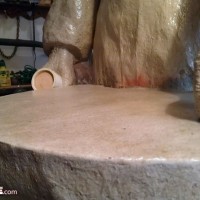When a blog reaches a certain point in its life, and the writer refuses to accept that the chainsaw has sung its last, he will typically post an apologetic article promising many upcoming topics, and he may even follow up on one or two, but you can usually bet that you’ll never hear from him again.
What it boils down to is appetite, or how savory a topic is to the writer. When he follows his gut, he’ll speak because he has something to say as opposed to jabbering with indifference, a sort of living death.
That said, perhaps it’s fitting that my first post in nearly a year should take the form of a rant.
“Gene”, whose name I inferred from his email address (an address which bounced when I sent my reply), asked the following question (Although lacking any punctuation, I must assume it was a question based on “can I use”):
can I use 1/2″ drill to make a flying ghost 200′ line 7 ghost
I tried using a 3/8 drill I keep burning them up
What follows is my reply:
Gene,
The challenge of parsing your question has exceeded this morning’s allotment of brain cells, so I’ll have to make some inferences and move forward from there. Your phrase “flying ghost 200′ line 7 ghost” is the real head scratcher here. Is that a flying crank ghost on a 200′ tall line? Gah! The crank would have to be enormous, so probably not. Perhaps you’re actually referring to an Axeworthy ghost that whirs around an area on a rope threaded through a system of pulleys. This sounds more reasonable.
If I were going to move a mass I would want to calculate the amount of energy needed to accomplish the job. In this case, you have the ghost prop plus the weight of the threaded line plus a certain amount of resistance in each pulley. That’s not a trivial calculation (for me, anyway) so I’d have to google it just to see how to write the equation. Failing that, I would see what other Axeworthy builders have used for drive motors and emulate the best solution.
However, if you’re really talking about a flying crank ghost, then I have to congratulate you on the level of stealth you’ve managed to wrap around its description. In any case, the answer is to stop using drills as drive motors.
A drill motor is not rated for continuous use no matter what its size. It will eventually overheat and seize up. Worse, it could get hot enough to cause a fire. I use a Dayton industrial AC motor (I don’t recall the model) to drive my crank ghost, and even that heats up to the point you can’t touch it. The point is that it is a high torque motor that is designed for continuous use so I don’t really worry about it. If it were an indoor prop, then I would investigate the heat issue so
that we don’t wake up some morning on fire. But it is outside in a mausoleum far from the house; perhaps after years of faithful service it’s in need of replacement. Bearings do wear out, after all.
I hope this has been helpful, and feel free to contact us again if you have any other well-worded and properly punctuated questions.
Your ol’ pal Spook gets the snark prize on this one. (There’s a good reason why Grumble has been accused of being my alter ego.) In my defense, maybe I wouldn’t have fallen off the reservation if my reply had actually reached its intended eyes, but it came back undeliverable, which perfectly punctuates the unpunctuated level of fail on display here.
Call it a public service announcement if you’re feeling very charitable. Maybe “Gene” will find this, turn off that drill that’s been grinding itself to ruin for the past four hours, and not burn down his haunt with a blazing flying ghost 200′ 7 ghost.
Category: From The Undead Letter Office, Halloween
Tags: Fail, flying crank ghost





























